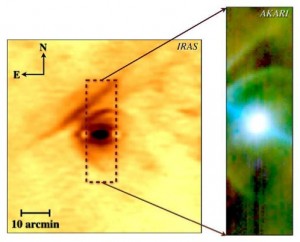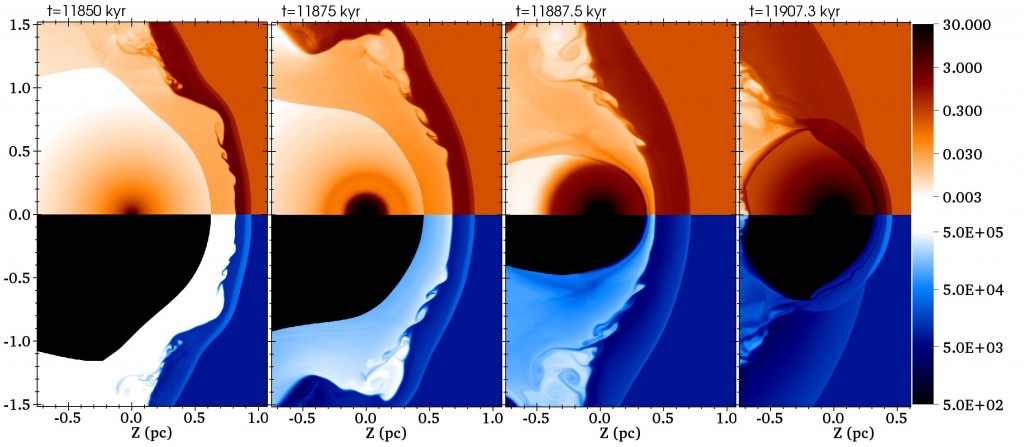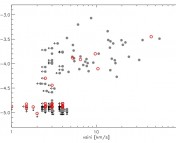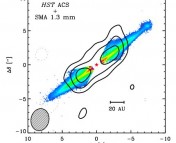Title: 3D Simulations of Betelgeuse’s Bow Shock
Author: Shazrene Mohamed, Jonathan Mackey, Norbert Langer
Institution: Argelander-Institut fur Astronomie, Bonn, Germany
Title: Double bow shocks around young, runaway red supergiants: application to Betelgeuse
Author: Jonathan Mackey, Shazrene Mohamed, Hilding R. Neilson, Norbert Langer, Dominique M.-A. Meyer
Institution: Argelander-Institut fur Astronomie, Bonn, Germany

Images of Betelgeuse in the infrared (left: from IRAS catalog of Cao et al., 1997; right: a composite color image using AKARI from Ueta et al. 2008). The circular feature is called a bow shock and the "bar" is the driver behind this research. Figure 1 from Mohamed et al. (2012); credit ATARI MLHES team.
Sometimes we see strange shapes when we finally reduce the data from our fancy telescopes and we’re left wondering how they formed. How did the rings and “pearls” of SN1987A form? Or the hexagonal cloud pattern on Saturn? What stretched this galaxy into such a bizarre – and beautiful – shape? We know the creation stories or have ideas for some of these: Saturn’s strangely angular clouds are likely a fluid phenomenon, the distorted galaxy is gravitationally lensed by the foreground galaxy. And if anyone has a short and sweet explanation for the structure of SN1987A, please share! The star Betelgeuse – famous for being Orion’s left shoulder – presents another unusual geometric appearance and is the subject of the two papers I’ll summarize today. An image of Betelgeuse in the infrared is shown to the right; the star is surrounded by a horseshoe and accompanied by a “mysterious bar” (the oddly linear structure to the northeast).
The fundamental behavior underlying the structure seen around Betelgeuse is its stellar wind and the fact that it is moving through the interstellar medium (ISM). Betelgeuse is a red supergiant and is losing mass via a dense stellar wind. Like many massive stars, it is on the run, having been dynamically ejected from the binary or cluster in which it formed. As the fast-moving stellar wind encounters the ISM, it sends a shock through the surrounding material. Because the star is moving, its stellar wind impacts the gas in front of it like a ship plowing through water (not coincidentally, this is called a “bow shock“). The shocked material is hot and shows up rather well in infrared images such as the one to the right – the horseshoe is Betelgeuse’s bow shock.
A recent publication by Mohamed et al. (2012) simulated the shock in 3D for the first time, finding that instabilities play an important role in the shock morphology. The figure to the left shows the results of one of their simulations after the bow shock has been established. This is the view from edge on (imagine Betelgeuse moving to the left across this image). Where the density is highest, you see a bow shock.
Importantly, if the mass of material in the shock is small as suggested by recent observations, the shock is young: less than 30,000 years old. In astronomy terms, this was just yesterday! This would mean one of two things: either Betelgeuse has moved into a region of the ISM with different properties (and material surrounding it has changed) or that Betelgeuse has undergone recent evolution (and its stellar wind has changed). A young shock also is consistent with the smooth, circular nature of the shock: in their simulations, older shocks are clumpier and become parabolic.
Mohamed et al. suggested that Betelgeuse has only recently evolved from being a blue supergiant (BSG) to being a red supergiant (RSG). If this is true, then they may have an explanation for the mysterious bar. As a blue supergiant or as a main sequence star, Betelgeuse could also have blown a shock in the surrounding ISM. Perhaps the bar is a remnant of the stellar wind from a previous stage of its evolution. It is this idea that is the basis for the work of Mackey et al. (2012).
Mackey et al. model Betelgeuse’s effect on its environment as it transitions from a BSG to a RSG. The key ingredient is the evolution of the stellar wind, which changes as the star makes this transition. The figure below shows the results of their simulation (a video is also available). From left to right, time increases. The top half of the panel shows the number density of gas particles and the bottom half shows the temperature of the gas (the same part of the simulated region is shown in both halves). As the BSG phase ends (panel A), a bubble and single bow shock, driven by the BSG stellar wind, are seen. When Betelgeuse becomes a RSG, the BSG wind bubble is no longer being driven and so collapses. Thus, beginning in panel B, you can see the BSG shock getting closer to the star itself while the RSG wind is blowing a new bubble. In panel C, the expanding RSG wind and the collapsing BSG bubble have collided, producing a shell of shocked gas that resembles a bow shock. The star ends its life in panel D, with the RSG wind overtaking the BSG bow shock and creating a new shock in the ISM.
Panel C most closely resembles the infrared image of Betelgeuse that I showed at the beginning of the post. It is also is a good match to the mass thought by Mohamed et al. to be contained in the shock. In this scenario, the “bow shock” observed is a shell of shocked gas where the RSG wind and the BSG wind bubble (driven by the star during its blue supergiant phase) meet. The perhaps not-so mysterious bar seen in the infrared image is the remnant of the bow shock from the blue supergiant phase. This configuration lasts for only 10,000 years; but, while this is may seem like very short time frame for those who think in astronomical time scales, it is actually a significant portion of the time a star spends as a red supergiant.







This is so cool, thank you for the clear explanation of this paper. The image of bow shock makes the explanation of the horseshoe structure quite clear. If the bar shaped structure is probably from a change in the stellar wind though, why does it take the shape we observe? Why is it so linear? And why is it ahead of Betelgeuse, if the horseshoe is like the “bow,” wouldn’t we expect the bar to be behind the star as if a stellar wind were emitted and then left trailing behind?